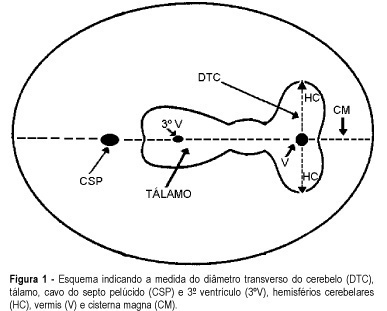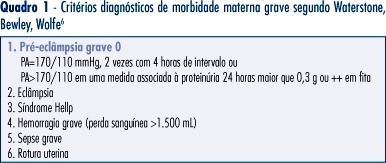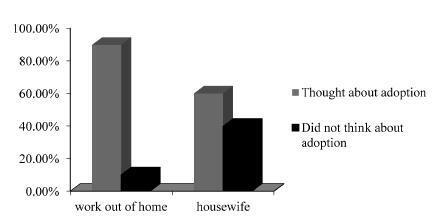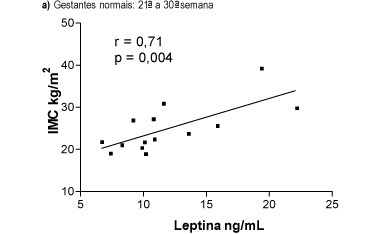Summary
Revista Brasileira de Ginecologia e Obstetrícia. 2000;22(5):281-286
DOI 10.1590/S0100-72032000000500005
Purpose: to evaluate the effectiveness of the transverse cerebellar diameter (TCD), by ultrasonography, in the evolution of the fetal growth, and to relate it to gestational age, biparietal diameter (BPD), head circumference (HC), abdominal circumference (AC) and femur length (FL). Method: a prospective and longitudinal study was performed on 254 pregnant women considered of low risk, with a gestational age from 20 to 40 weeks. Only 55 pregnant women were included in the study, according to inclusion and exclusion criteria. All the examinations, 217 ultrasonographic evaluations, were done by the author (LN), at least three and at most six examinations for each pregnant woman being accomplished at an interval of one to five weeks. Normality patterns were established between the 10 and 90 percentiles for each gestational age and confirmed postnatally. Results: the transverse cerebellar diameter presented a good correlation with the gestational age either as a dependent variable (R² = 0.90) or as an independent variable (R² = 0.92). A significant relationship was found in the evaluation of the fetal growth between the TCD and the several fetal parameters: BPD and HC (R² = 0.92), FL (R² = 0.90) and AC (R² = 0.89). Conclusions: the transverse cerebellar diameter is a parameter that should be used in the follow-up of development and of fetal growth because of the ascending pattern of its growth curve. Any up- or downward alteration in the growth curve can be useful for the detection of deviations of fetal growth.

Summary
Revista Brasileira de Ginecologia e Obstetrícia. 2008;30(6):281-286
DOI 10.1590/S0100-72032008000600003
PURPOSE: to assess the prevalence and risk factors associated with near miss and other severe maternal morbidity at a reference tertiary maternity. METHODS: this is a cross-sectional study on severe maternal morbidity at the Hospital e Maternidade Celso Pierro, Campinas, São Paulo, between October 2005 and July 2006, identified from infirmary, admission and delivery unit logbooks. Pregnant and post-partum women with severe maternal morbidity were identified according to clinical criteria proposed by Waterstone. Later, cases with more severe morbidity, called extremely severe maternal morbidity, were reclassified using Mantel criteria, based on organic dysfunction and clinical management. RESULTS: there were 114 severe maternal morbidity cases among 2,207 birth deliveries, with a ratio of other severe morbidity and extremely severe morbidity near miss of 44.9 and 6.8 cases/1,000 live births, respectively. Mean gestational age at delivery was 35 weeks, and 87% came from the reference area for the maternity service. Hypertension (severe pre-eclampsia) represented 96% of other severe morbidity, while hemorrhage represented 60% of all extremely severe cases, followed by hypertension. The prevalence of extremely severe morbidity among the severe morbidity cases was not associated with marital status, schooling, maternal age, type of delivery, parity, gestational age at birth and home place. CONCLUSIONS: the other morbidities were 6.6 times more frequent than near miss, and it was not possible to differentiate both groups by epidemiological risk factors.

Summary
Revista Brasileira de Ginecologia e Obstetrícia. 2007;29(6):281-284
Summary
Revista Brasileira de Ginecologia e Obstetrícia. 2017;39(6):282-287
The views of infertile couples regarding oocyte donation by third parties and adoption are unknown, as these may be interpreted as a final closure of the available options for conception. This study aimed to determine the acceptance of oocyte donation, oocyte reception, and child adoption of infertile women who submitted to assisted reproductive technology (ART) treatment
Sixty-nine women who were under treatment for infertility and submitted to ART procedures were included in this cross-sectional study. They were evaluated using semi-structured questionnaires administered during ovulation induction in a treatment cycle. Marital status, religion, years of schooling, occupation, type of infertility, age, duration of infertility, number of previous ART cycles, mean oocyte number per cycle, and mean number of embryos per cycle had no influence on a woman’s acceptance of oocyte donation or oocyte reception.
More than 90% of the patients thought that the subject of “adoption” should be brought up during their ART treatments, although they preferred to discuss this topic with psychologists, not doctors. Women with occupations were more willing to consider adoption.
The opinions of these patients on these issues seem to be based on personal concepts and ethical, religious, and moral values. Women preferred to discuss adoption with psychologists rather than doctors.

Summary
Revista Brasileira de Ginecologia e Obstetrícia. 2001;23(5):283-287
DOI 10.1590/S0100-72032001000500003
Purpose: to study in primigravid adolescents the behavior of serum leptin levels during the evolution of normal pregnancy, comparing the results with those obtained from preeclamptics. Methods: prospective, longitudinal study conducted in 15 normotensive pregnant adolescents and 5 preeclamptic adolescents. Serum leptin levels (ng/mL) were determined by radioimmunoassay. Blood pressure was measured by the oscilometric method by using DINAMAP 1846. Patients were evaluated in two different gestational periods: between the 21st and 30th week and between the 31st and 40th week. The ratio leptin/body mass index (BMI) was used to correct changes observed in BMI throughout gestation. Preeclamptic pregnant patients were diagnosed when the blood pressure was > or = 140/90 mmHg, proteinuria >300 mg/24 h and when arteriolar spasm was present in the optic fundi. Results: there was a trend towards an elevation of serum leptin at the end of pregnancy in both groups although more pronounced in preeclamptic patients. In pregnant normotensive patients serum leptin increased from 11.9±1.20 (21stto 30th week) to 13.9±2.23 ng/mL (31st to 40th week), and in preeclamptic from 11.9±1.20 to 17.6±4.565 ng/mL. In preeclamptic patients the BMI increased significantly in the period from the 21st to 30th week when compared to the period between the 31st and 40thweek: 21.5±0.8 vs 27.4±1.7 kg/m², p<0.05.In normotensive these values were maintained stable: 24.9±1.5 vs 25.1±1.00 kg/m². At the end of gestation the ratio leptin/BMI was significantly higher in preeclamptics: 0.56±0.06 (21stto 30thweek) vs 0.70±0.15, p<0.05. The values of the ratio leptin/BMI in normotensive pregnants varied from 0.44±0.02 between the 21st and 30th week to 0.41±0.04 between the 31st to 40thweek. In normal pregnants there was a direct and significant correlation between the levels of leptin and BMI in both periods of pregnancy: r = 0.7, p<0.004 (31st to 40th ) vs r = 0.94, p<0.0001 (31st to 40th week). These correlations were lost in preeclamptic patients in both gestational periods. Conclusion: the higher concentrations of leptin and leptin/BMI ratio observed when preeclamptics were compared with normotensive patients, in both gestational periods, suggest a leptin resistance pattern in preeclampsia.

Summary
Revista Brasileira de Ginecologia e Obstetrícia. 1998;20(5):283-287
DOI 10.1590/S0100-72031998000500008
Turner syndrome and its complications, hydrops and cystic hygroma, can produce alterations in maternal serum biochemical markers used in screening for Down's syndrome and neural tube defects (NTD). The authors report the case of a 37-year-old pregnant woman, screened for Down's syndrome and NTD in the second trimester of pregnancy. The maternal serum alpha-fetoprotein (MSAFP) level was increased and the test was considered screen positive for NTD. A three-dimensional ultrasound investigation was performed, but no fetal or placental anomalies were found, indicating a case of unexplained increased msafp. In the third trimester severe oligohydramnios and disturbances in uteroplacental arterial circulation developed, requiring corticosteroid therapy and premature cesarean section at the 34th week of gestation. The female newborn was transferred to a neonatal ICU and tetralogy of Fallot and Turner syndrome were diagnosed. This case prompted the authors to review the literature on maternal serum biochemical markers in Turner syndrome and congenital heart defects and to propose a protocol for unexplained increased MSAFP.